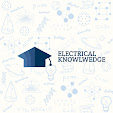SYNCHRONOUS MACHINES
SYNCHRONOUS MACHINES
SYNCHRONOUS MACHINES
Physical Description of a Synchronous Machine
1. Consists of two sets of windings:
# phase armatures winding on the stator distributed with center’s 120° apart in space
#field winding on the rotor supplied by DC
2. Two basic rotor structures used:
# salient or projecting pole structure for hydraulic units (low speed)
# round rotor structure for thermal units (high speed)
3. Salient poles have concentrated field windings; usually, also carry
damper windings on the pole face.
Round rotors have solid steel rotors with distributed windings
4. Nearly sinusoidal space distribution of flux wave shape obtained by:
# distributing stator windings and field windings in many slots (round
rotor);
# shaping pole faces (salient pole)
Rotors of Steam Turbine Generators
1. Traditionally, North American manufacturers normally did not provide
special “damper windings”
# solid steel rotors offer paths for eddy currents, which have effects
equivalent to that of amortisseur currents
# European manufacturers tended to provide for additional damping
effects and negative-sequence current capability
# wedges in the slots of field windings interconnected to form a damper
case, or
# separate copper rods provided underneath the wedges
Rotors of Hydraulic Units
1. Normally have damper windings or amortises
# non-magnetic material (usually copper) rods embedded in pole face
# connected to end rings to form short-circuited windings
2. 2. Damper windings may be either continuous or non-continuous
3. Space harmonics of the armature MMF contribute to surface eddy current
therefore, pole faces are usually laminated
Balanced Steady-State Operation
1. mmf wave due to the three phase stator windings:
# travels at synchronous speed
# appears stationary with respect to the rotor
# has a sinusoidal space distribution
2. mmf wave due to one phase:

Balanced Steady-State Operation
of stator MMF wave and its relative angular position with respect to
rotor MMF wave depend on machine output
for generator action, rotor field leads stator field due to forward
torque of prime mover;
for motor action, rotor field lags stator field due to retarding torque
of shaft load
Direct and Quadrature Axes
The rotor has two axes of symmetry
For the purpose of describing synchronous machine characteristics, two
axes are defined:
the direct (d) axis, centered magnetically in the center of the north
pole
The quadrature (q) axis, 90 electrical degrees ahead of the d-axis









No comments:
If you have any doubts, please let me know